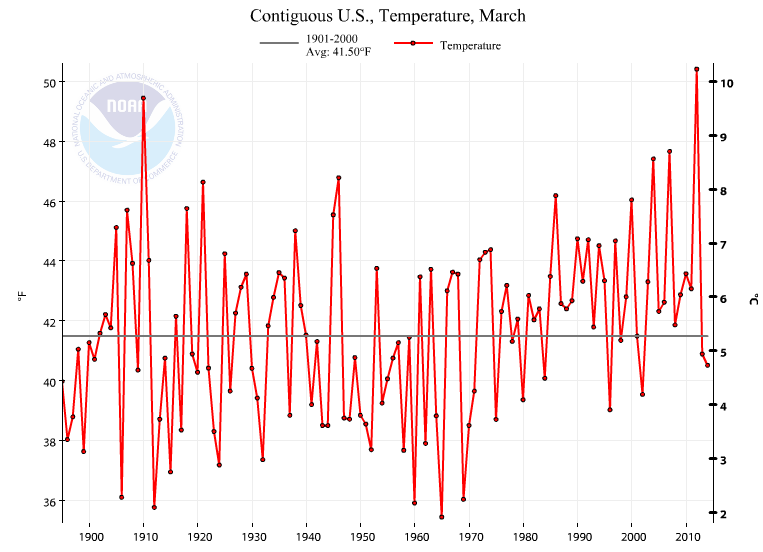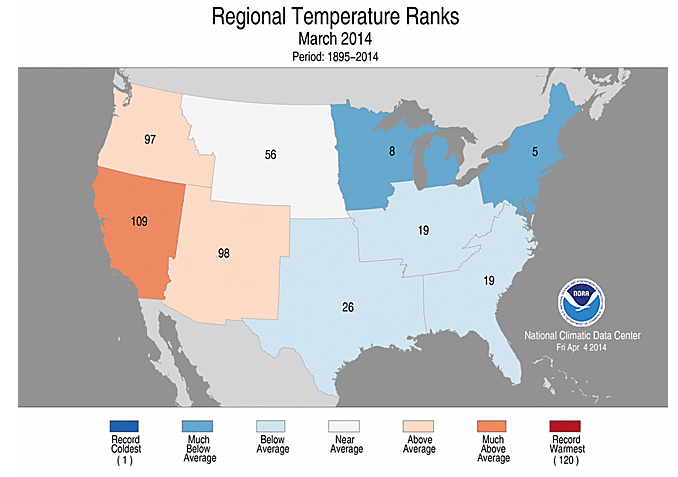Data Analysis Exercise
Part One
PART ONE: ONE
Rank
|
Top
Ten Warmest
|
Top
Ten Coldest
|
1
|
2012
|
1917
|
2
|
1998
|
1904
|
3
|
1931
|
1950
|
4
|
1987
|
1924
|
5
|
2006
|
1951
|
6
|
1999
|
1912
|
7
|
1921
|
1929
|
8
|
2005
|
1972
|
9
|
2001
|
1907
|
10
|
2010
|
1979
|
The
information in letter a-f show that, while temperatures have not jumped up by
10°F, they have increased by a few degrees, noticeably, over the last 40 years.
It relates to the current debates about climate change because it shows that,
over a 118 year period, temperatures on national and regional scales are rising
slightly. The tabular data shows that 5/10 warmest years on record for the
Upper Midwest region occurred after 2000. Other data that could be used to see
if global climates are changing are data from around the world to see if the
trend is global, sea-level data over the last 100+ years, global drought
conditions, and maybe even documentation of elevation range changes for species
to determine if they are being pushed towards more familiar climates and climbing
in elevation. Unfortunately, all the data that every compiled can be made
available, but there are still a large number of people who do not believe in
climate change, as well as a large number of people who do not take the
initiative to educate themselves on the matter.
Value
|
Rank
|
Anomaly
|
|
191712
|
38.8
|
1
|
-4.2
|
190412
|
40.1
|
2
|
-2.9
|
195012
|
40.2
|
3
|
-2.8
|
192412
|
40.5
|
4
|
-2.5
|
195112
|
40.6
|
5
|
-2.4
|
191212
|
40.7
|
6
|
-2.3
|
192912
|
40.7
|
7
|
-2.3
|
197212
|
40.9
|
8
|
-2.1
|
190712
|
41
|
9
|
-2
|
197912
|
41.1
|
10
|
-1.9
|
199612
|
41.1
|
11
|
-1.9
|
191612
|
41.2
|
12
|
-1.8
|
192612
|
41.4
|
13
|
-1.6
|
190312
|
41.5
|
14
|
-1.5
|
189512
|
41.6
|
15
|
-1.4
|
197812
|
41.6
|
16
|
-1.4
|
189912
|
41.7
|
17
|
-1.3
|
193612
|
41.7
|
18
|
-1.3
|
190512
|
41.8
|
19
|
-1.2
|
193712
|
41.9
|
20
|
-1.1
|
196512
|
41.9
|
21
|
-1.1
|
196712
|
41.9
|
22
|
-1.1
|
189712
|
42
|
23
|
-1
|
190912
|
42
|
24
|
-1
|
194312
|
42
|
25
|
-1
|
194512
|
42
|
26
|
-1
|
198512
|
42
|
27
|
-1
|
198912
|
42
|
28
|
-1
|
199312
|
42
|
29
|
-1
|
196612
|
42.1
|
30
|
-0.9
|
198212
|
42.1
|
31
|
-0.9
|
194012
|
42.2
|
32
|
-0.8
|
192712
|
42.3
|
33
|
-0.7
|
196912
|
42.3
|
34
|
-0.7
|
192012
|
42.4
|
35
|
-0.6
|
196212
|
42.4
|
36
|
-0.6
|
200812
|
42.4
|
37
|
-0.6
|
189612
|
42.5
|
38
|
-0.5
|
193512
|
42.5
|
39
|
-0.5
|
196012
|
42.5
|
40
|
-0.5
|
197012
|
42.5
|
41
|
-0.5
|
191512
|
42.6
|
42
|
-0.4
|
192512
|
42.6
|
43
|
-0.4
|
201312
|
42.6
|
44
|
-0.4
|
197612
|
42.7
|
45
|
-0.3
|
189812
|
42.8
|
46
|
-0.2
|
190212
|
42.8
|
47
|
-0.2
|
193212
|
42.8
|
48
|
-0.2
|
195812
|
42.8
|
49
|
-0.2
|
190112
|
42.9
|
50
|
-0.1
|
191412
|
42.9
|
51
|
-0.1
|
191812
|
42.9
|
52
|
-0.1
|
191912
|
42.9
|
53
|
-0.1
|
194712
|
42.9
|
54
|
-0.1
|
195612
|
42.9
|
55
|
-0.1
|
195912
|
42.9
|
56
|
-0.1
|
197112
|
42.9
|
57
|
-0.1
|
200912
|
42.9
|
58
|
-0.1
|
192312
|
43
|
59
|
0
|
195712
|
43
|
60
|
0
|
197412
|
43
|
61
|
0
|
190612
|
43.1
|
62
|
0.1
|
192812
|
43.1
|
63
|
0.1
|
198012
|
43.1
|
64
|
0.1
|
194812
|
43.2
|
65
|
0.2
|
196312
|
43.2
|
66
|
0.2
|
199712
|
43.2
|
67
|
0.2
|
191012
|
43.3
|
68
|
0.3
|
197512
|
43.3
|
69
|
0.3
|
199512
|
43.3
|
70
|
0.3
|
191112
|
43.4
|
71
|
0.4
|
196112
|
43.4
|
72
|
0.4
|
199212
|
43.4
|
73
|
0.4
|
191312
|
43.5
|
74
|
0.5
|
194212
|
43.5
|
75
|
0.5
|
196812
|
43.5
|
76
|
0.5
|
199412
|
43.5
|
77
|
0.5
|
195512
|
43.6
|
78
|
0.6
|
197712
|
43.8
|
79
|
0.8
|
198412
|
43.8
|
80
|
0.8
|
190012
|
43.9
|
81
|
0.9
|
193312
|
43.9
|
82
|
0.9
|
195212
|
43.9
|
83
|
0.9
|
200312
|
43.9
|
84
|
0.9
|
190812
|
44
|
85
|
1
|
192212
|
44
|
86
|
1
|
194912
|
44
|
87
|
1
|
195412
|
44
|
88
|
1
|
196412
|
44
|
89
|
1
|
198312
|
44
|
90
|
1
|
193012
|
44.1
|
91
|
1.1
|
198612
|
44.1
|
92
|
1.1
|
200412
|
44.1
|
93
|
1.1
|
193412
|
44.2
|
94
|
1.2
|
194412
|
44.2
|
95
|
1.2
|
198812
|
44.2
|
96
|
1.2
|
194612
|
44.3
|
97
|
1.3
|
193912
|
44.5
|
98
|
1.5
|
198112
|
44.5
|
99
|
1.5
|
200012
|
44.5
|
100
|
1.5
|
199112
|
44.6
|
101
|
1.6
|
201112
|
44.7
|
102
|
1.7
|
193812
|
44.8
|
103
|
1.8
|
195312
|
44.9
|
104
|
1.9
|
197312
|
44.9
|
105
|
1.9
|
200212
|
45
|
106
|
2
|
194112
|
45.2
|
107
|
2.2
|
199012
|
45.2
|
108
|
2.2
|
200712
|
45.2
|
109
|
2.2
|
201012
|
45.6
|
110
|
2.6
|
200112
|
45.7
|
111
|
2.7
|
200512
|
45.7
|
112
|
2.7
|
192112
|
46
|
113
|
3
|
199912
|
46
|
114
|
3
|
200612
|
46.7
|
115
|
3.7
|
198712
|
47.2
|
116
|
4.2
|
193112
|
47.5
|
117
|
4.5
|
199812
|
47.5
|
118
|
4.5
|
201212
|
47.9
|
119
|
4.9
|
PART ONE: TWO
Madison:
Minimum: January (16.0°F)
Maximum: July (71.0°F)
Milwaukee:
Minimum: January (18.9°F)
Maximum: July (70.9 °F)
Madison:
Minimum: January (1.1 in),
February (1.1 in)
Maximum: August (4.0 in)
Milwaukee:
Minimum: February (1.5 in)
Maximum: April (3.5 in), August
(3.5 in), September (3.5 in)
The temperature data shows what
would be expected when comparing the two cities. Milwaukee is right on a large
body of water, so it is warmer in the winter, because the temperature is warmed
by Lake Michigan. The summer temperature is very slightly cooler for Milwaukee,
which can also be attributed to the water cooling the surrounding areas. Milwaukee
is, on average, warmer than Madison in the winter and cooler than Madison in
the summer. For precipitation, another interesting trend emerged. Milwaukee did
not have the highest high amount of precipitation or the lowest low amount of
precipitation. Milwaukee did have the most precipitation, however, and had a
much smaller difference between the high and low months. Madison was much more
sporadic, having slightly less rainfall, higher highs, and lower lows.
PART ONE: THREE
Precipitation to
Date
|
||
City
|
Rainfall
|
Snowfall
|
Minneapolis
|
1.84
|
7.0
|
Eau Claire
|
2.67
|
9.1
|
La Crosse
|
No Records Available
|
No Records Available
|
Eau Claire has more rainfall
precipitation and snowfall than Minneapolis. Both Minneapolis and Eau Claire
get their data from a station in Chanhassen, MN. Since Minneapolis is much
closer to Chanhassen, the reports are most likely much more precise than those
in Eau Claire, as the station would have to make estimates for what the values
will be when they reach Eau Claire.
PART ONE: FOUR
The data mostly spans from
1961-1990, so it is dated and not able to properly the current climate
situations that we are currently experiencing. The difference in the data is
for the initial average rainfall data, which looks at 1949-1995, a forty-five year
span, versus the other data, which looks at a thirty-year span. So the data is
dated and inconsistent when it comes to measuring methods.
 |
| This climograph for Madison shows two spikes in precipitation in June and August, and a sharp drop during the hottest month of the year, July. |
 |
| This climograph for Wausau shows the drop in precipitation during the hottest part of the year, July. The precipitation peaks in August and stays almost the same level for September. |
PART ONE: FIVE
When
comparing data to more than one location, the ability to gain a comprehensive
view of an area is possible. If one looks at Minneapolis, their idea may be
skewed because the temperatures in Minneapolis are slightly warmer than the
surrounding areas due to the urban heat island effect. Small local differences,
such as this, are why a comprehensive view of an area can only be gathered when
looking at more than one location.
PART ONE: SIX
As
stated before, local differences can have a big affect on the averages, raising
or lowering them, depending on the region. Lake Effect, Urban Heat Island,
Windward/Leeward Positions, and a number of other things can affect the
temperatures and precipitation totals.
PART ONE: SEVEN
The
various techniques used can also have a big effect. The number of years that are
observed, how recent the data is, the equipment used, how regular the recording
is, and a number of other things will affect the data. If data is recorded
every once in a while, at non-regular intervals, it will be more easily skewed
then the opposite. Old data will not be as useful if trying to determine local
climates, because the data has changed significantly in recent years.
PART TWO
























No comments:
Post a Comment